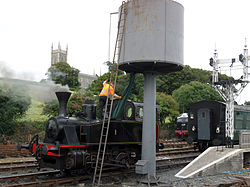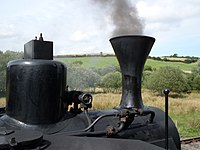Downpatrick & County Down Railway
| Downpatrick & County Down Railway | |
|
County Down | |
|---|---|

| |
| Gauge: | Irish |
| Location: | 54°19’34"N, 5°43’19"W |
| Track: | 1½ miles |
| Information | |
The Downpatrick & County Down Railway is a heritage railway and rail restoration project run by volunteer enthusiasts in County Down. The project is based at Downpatrick, and maintains and restores the heritage of the Belfast & County Down Railway, from which it takes its name, running trains on a remaining part of the B&CDR track.
The railway has a triangular layout. It connects two local tourist attractions; Inch Abbey to the north, and a locally famous Viking site ('King Magnus' Grave') to the south. It is intended, money and volunteers permitted, to extend the railway to reach an 18th-century corn mill to the south near Ballydugan. An extension north to Comber or all the way south to the seaside town of Newcastle remain long-term ambitions.
History
Local architect Gerry Cochrane MBE was inspired to start the scheme after taking a walk along the route of the line, and by 1982 had gained support from the local council to rebuild part of the Belfast & County Down Railway as a heritage steam railway.[1] Lord Dunleath, whose father had purchased the railway trackbed adjacent to his estate after the closure of the B&CDR in Downpatrick, gave the newly formed society a package of land on which to build the line and station for a peppercorn rent. This was on the approaches to the old Downpatrick station, which had been demolished in the 1970s.
Work started on rebuilding the railway in 1985, with public trains finally running in the town again in December 1987,[1] making it the first Irish gauge heritage railway in Ireland to carry passengers over its own track. Track has been relaid on nearly 4 miles of Belfast and County Down Railway trackbed, and a 1-mile extension south to the hamlet of Ballydugan has been proposed.
The railway began life as the Downpatrick & Ardglass Railway, as the original intention was to extend the railway to this fishing port on the south coast of County Down. This name was dropped in 1996 following the abandonment of this proposal and the railway was renamed the Downpatrick Railway Museum until 2005 when the new name, Downpatrick & County Down Railway was adopted following the opening of the Inch Abbey extension.[1]
The Downpatrick & County Down Railway was the subject of a BBC1 Northern Ireland 40-minute documentary, "Raising Steam", which was broadcast on Monday 14 January 2008.[2] It has also appeared in numerous other TV productions by BBC, UTV, RTÉ and independent programme makers.
Operation

The railway runs a regular passenger service at weekend afternoons from Downpatrick to Inch Abbey a mile and a half away.
At the station in Downpatrick are workshops in which locomotives and more particularly carriages, are restored by volunteers. It also contains standing exhibitions on the Belfast & County Down Railway and its successor lines after nationalisation as part of Ulster Transport.
Rolling Stock
Approximately 3 miles of Irish gauge track are open, along which one Orenstein and Koppel steam locomotive and some early 1960s era diesel locomotives (three CIÉ G611 Class and two CIÉ E421 Class) are run, drawing preserved rolling stock, including no. 836, a carriage built for the Great Southern and Western Railway in 1902. The DCDR has also introduced back into service 1896-built BCDR No 148, the first Belfast and County Down Railway coach to be restored by the railway and the oldest operational passenger carrying railway vehicle in Ireland. After withdrawal from traffic in the mid 1950s, 148 did duty as a henhouse until rescued by the DCDR in 1987.
The railway also operates one of the prototype BR-Leyland Railbuses, RB3, which was modified in the early 1980s to run on Irish metals and was used for a period by Northern Ireland Railways. The railway has also been donated by Irish Rail, with a Sligo, Leitrim and Northern Counties Railway Railcar B, built in 1948. This railcar is in poor condition and it will be some time before the DCDR can return it to operational condition. A second O&K steam locomotive is also under restoration.
A 0-6-0 tank engine built in 1875, GSWR No.90, was delivered to Downpatrick in October 2007 after overhaul at the workshops of the Railway Preservation Society of Ireland in Whitehead, Co Antrim, and this is Ulster's oldest operational steam engine. A mainline diesel locomotive, CIÉ A class locomotive no.A39 was moved to the railway in November 2009. This locomotive is on loan from the Irish Traction Group. ITG-owned 141 class locomotive No.146 joined the railway's fleet in late November 2010.[3]
Steam Locomotives
- Orenstein and Koppel 0-4-0T No. 1 built in 1934. Operational, returned to service in 2012.
- Orenstein and Koppel 0-4-0T No. 3 built in 1935. operational, returned to service in 2014
- Great Southern and Western Railway 0-6-0T No. 90 built in 1875. Operational. / But on display.
Outside links
| ("Wikimedia Commons" has material about Downpatrick & County Down Railway) |
- Downpatrick & County Down Railway
- "Raising Steam". BBC Northern Ireland. 2008. http://www.bbc.co.uk/northernireland/tv/programmes/steam/index.shtml.
References
- ↑ 1.0 1.1 1.2 Cochrane, Gerry (2009). Back in Steam: the Downpatrick and County Down Railway from 1982. Newtownards: Colourpoint. ISBN 978-1-906578-29-9.
- ↑ Raising Steam.
- ↑ "American Baby Boomer adopted by Downpatrick Railway". Latest News. Downpatrick & County Down Railway. 2010-11-29. http://www.downrail.co.uk/news2010.htm. Retrieved 2012-07-23.
